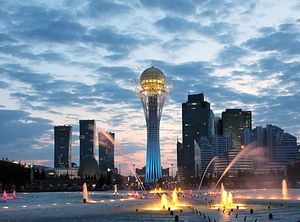On Saturday, while Kazakh police were rounding up potential protesters near the Baiterek monument, Foreign Minister Erlan Idrissov was meeting with Chinese Foreign Minister Wang Yi.
That the protests were linked to simmering frustrations about changes to the Land Code that rumor said could lead to the Chinese purchase of Kazakh land is a coincidence–but one that highlights the tension between national-level plans and varying public sentiments.
Wang made stops in Kazakhstan and Kyrgyzstan over the weekend en route to the Shanghai Cooperation Organization foreign ministers meeting in Uzbekistan today. At each stop, Yi and his Central Asian counterparts extolled the great virtues of their mutual endeavors, particularly the Silk Road Economic Belt (the land-based portion of the One Belt, One Road initiative).
Xinhua’s coverage of the Wang-Idrissov meeting is effusive in its praise and makes no mention of the attempted-protests in Astana and elsewhere. Wang noted that “China and Kazakhstan are comprehensive strategic partners” which “enjoy a traditional friendship” and Idrissov said Kazakhstan “is greatly satisfied with the fruitful industrial cooperation between the two countries.” Kazakhstan, Xinhua reports, “stands ready to work with China to join the ‘Nurly Zhol’ and Silk Road Economic Belt proposal.”
As I wrote last December, when Kazakh Prime Minister Karim Massimov was visiting his counterpart in Beijing, there is a degree of synergy in some of the large reform and development schemes in both Kazakhstan and China:
Indeed, several economic plans between Kazakhstan and China fit nicely together. The Belt portion of China’s economic integration plan, first iterated during Xi’s September 2013 visit to Central Asia, is a targeted revival of the Silk Road. In November 2014, Kazakh President Nursultan Nazarbayev unveiled Nurly Zhol, the bright (or sunny) path, which is essentially an infrastructure development initiative… Other Kazakh initiatives — the 2050 Strategy and the 100 Steps – also are predicated foreign investment — with China an obvious source.
In Kyrgyzstan, Xinhua reported Bishkek’s “positive response” to the Belt initiative and Reuters reported that the Kyrgyz government is in talks to score a dozen relocated Chinese manufacturing plants. China has also been floated as a potential investor for the country’s massive hydropower projects which Russia had to pull out of for fiscal reasons. While Kyrgyzstan doesn’t have 5-year plan style development agendas, it nonetheless buys into the framework pushed by the Chinese foreign ministry of linking bilateral initiatives to the grand vision.
This theme–of linking regional initiatives to the grand Chinese plan to revitalize the Silk Road–defined Wang’s trip in the region. In Uzbekistan, the link was made with the SCO and also the Eurasian Economic Union (EEU). These connections are less clear, particularly how Russia and China can fuse their individual economic machines together. The EEU, as an economic vehicle, is inward-focused. It’s an outgrowth of a customs union and very much defined by its borders (members are present are Russia, Kazakhstan, Belarus, Armenia, and Kyrgyzstan). The Belt and Road initiative, on the other hand, is almost the exact opposite, defined by the borders it crosses and outwardly focused.
These seeming contradictions aside, Wang urged speedy action: “China and Russia should speed up linking the Silk Road Economic Belt and EAEU, in order to collect early harvest.”
It’s still unclear exactly what either side means by linking the two initiatives together.

































